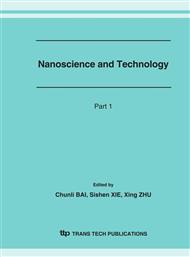[1]
N. M. Lawandy, R. M. Balachandran, A.S.L. Gomes, and E. Sauvain, Nature 368, 436 (1994).
Google Scholar
[2]
W. Sha, C. -H. Liu, and R. Alfano, J. Opt. Soc. Amer. B 19, 1922 (1994).
Google Scholar
[3]
M.A. Noginov, H.J. Caulfield, N.E. Noginova, and P. Venkateswarlu, Opt. Commun 118 430 (1995).
Google Scholar
[4]
D. Zhang, B. Cheng, J. Yang,Y. Zhang,W. Hu, and Z. Li, Opt. Commun. 118, 462 (1995).
Google Scholar
[5]
M. Siddique, R.R. Alfano, G.A. Berger, M. Kempe, and A.Z. Genack, Opt. Lett. 21, 450 (1996).
Google Scholar
[6]
G. van Soest, M. Tomita, and A. Lagendijk, Opt. Lett., 24, 306 (1999).
Google Scholar
[7]
G. van Soest, F. J. Poelwijk, R. Sprik, and A. Lagendijk, Phys. Rev. Lett. 86, 1522 (2001).
DOI: 10.1103/physrevlett.86.1522
Google Scholar
[8]
S. John and G. Pang, Phys. Rev. A, 54, 3642 (1996).
Google Scholar
[9]
D. S. Wiersma and A. Lagendijk, Phys. Rev. Lett. 54, 4256 (1996).
Google Scholar
[10]
R. M. Balachandran, N. M. Lawandy, and J. A. Moon, Opt. Lett. 22, 319 (1997).
Google Scholar
[11]
G. A. Berger, M. Kempe, and A. Z. Genack, Phys. Rev. E 56, 6118 (1997). [12] H. Cao, Y. G. Zhao, H. C. Ong, S. T. Ho, J. Y. Dai, J. Y. Wu, and R. P. H. Chang, Appl. Phys. Lett. 73, 3656 (1998).
Google Scholar
[13]
H. Cao, Y. Zhao, S.T. Ho, E.W. Seelig, Q.H. Wang, and R.P.H. Chang, Phys. Rev. Lett. 82, 2278 (1999).
Google Scholar
[14]
S. V. Frolov, Z. V. Vardeny, K. Yoshino, A. Zakhidov, and R. H. Baughman, Phys. Rev. B 59, R5284 (1999).
DOI: 10.1103/physrevb.59.r5284
Google Scholar
[15]
C. Zacharakis, Applied Physics Letters 81, 2511 (2002).
Google Scholar
[16]
B. Raghavendra Prasad, Hema Ramachandran, Ajay Kumar Sood, C. K. Subramanian, Narendra Kumar, Applied Optics, 36, 7718 (1997).
Google Scholar
[17]
H. Cao, Physica B, 338, 215. (2003).
Google Scholar
[18]
H. Cao, J. Y. Xu, S. -H. Chang, and S. T. Ho, Physical Review E 61, 1985 (2000).
Google Scholar
[19]
R.M. Balachandran, D. P. Pacheco, and N.M. Lawandy, Applied Optics 35, 640 (1996).
Google Scholar
[20]
Y. Ling, H. Cao, A. L. Burin, M. A. Ratner, X. Liu, and R. P. H. Chang, Physics Review A 64, 063808-1 (2001) -10 0 10 20 30 40 50 60 70 80 90 100 110 120.
Google Scholar
1000 2000 3000 4000 5000 6000 7000 8000 9000.
Google Scholar
[11]
[01] [0] [0] Peak Intensity (a. u. ) Pump Energy Density (mJ/cm.
Google Scholar
[2]
) Emission Intensity(a. u. ) Pump Energy Density(mJ/cm.
Google Scholar
20 40 60 80 100 120 140 160.
Google Scholar
[4] [8] [12] [16] [20] [24] [28] [32] [36] [40] [44] [48] [52] [56] [60] [64] Linewidth(nm) Pump Energy Density(mJ/cm2 ) Figure 1 Peak emission intensity of PMMA film containing Rhodamine 590 and TiO2 particles plotted against pump energy density. The inset is its log-log curve. The lasing threshold is 5mJ/cm 2. Figure 2 Peak line-width of PMMA film containing Rhodamine 590 and TiO2 particles plotted against pump energy density 540 560 580 600 620 640 660 500 1000 1500 2000 2500 3000 3500 4000 4500 b a Emission Intensity (a. u. ) Wavelength (nm) 576 579 582 585 588 591 594 597 600 603 1000 2000 3000 4000 5000 6000 7000 Emission Intensity (a. u. ) Wavelength (nm) Figure 3 Emission spectra of PMMA film doped with Rhodamine 590 and TiO2 particles with a pumping energy density (a) 1. 9mJ/cm 2, (b) 50mJ/cm 2. a is scaled up by a factor of 5. Figure 4 The multimode output above the threshold in PMMA film containing rhodamine 590 and TiO2 nano-particles pumped at 60mJ/cm.
Google Scholar
[2]
Figure 5 (a) Internal (b) Surface structure photograph of PMMA film doped with Rhodamine 590 and TiO2 particles by using 400 times optics microscopy (c) topography of Scanning Probe Microscopy a b c.
Google Scholar


